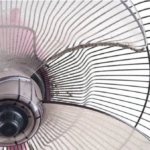During the hot summer days, besides electric fans, air conditioners are the leading cooling devices that serve people’s needs. The basic design of an air conditioner is usually a horizontal wall-mounted type, operating based on two main components: the indoor unit and the outdoor unit.
However, in addition to the conventional wall-mounted air conditioners, there are also vertical or standing air conditioners, also known as cabinet or tree air conditioners, available on the market. The operating principle of this type of air conditioner is similar to that of a regular air conditioner, but its appearance resembles a refrigerator. The air vents are not arranged horizontally across the entire body of the machine, but are located on the upper or lower part of the air conditioner.


Regular wall-mounted air conditioner and cabinet air conditioner (illustration)
Cabinet or tree air conditioners are highly appreciated by many users for their aesthetic appeal, as they not only serve as cooling devices but also help to decorate the space. Additionally, they are easier to install compared to traditional wall-mounted air conditioners. However, there is a question that many users have, which is whether the newer cabinet air conditioners consume more electricity compared to the traditional wall-mounted air conditioners.
Important air conditioner specifications
According to air conditioner manufacturers and distributors, to answer this question, users need to consider the specifications of the devices. In addition to the power specifications, there is another important specification that is equally crucial and influences the amount of electricity consumed by the device. This specification is measured in BTU (British Thermal Unit).
When purchasing an air conditioner, users are usually advised to determine the area of the space to be cooled and then choose a device with the appropriate BTU specification. BTU is an abbreviation for “British Thermal Unit,” which is a unit of measurement used in many countries worldwide, such as the United States and the United Kingdom. It indicates how much energy a air conditioner needs to remove heat from a space in one hour. According to Trane.com, BTU is not only applicable to air conditioners, but also to furnaces, heat pumps, cooking appliances, and other heating and cooling devices.

BTU specification displayed on an air conditioner product (illustration)
Experts explain that users can simply understand that the BTU value reflects the cooling capacity of an air conditioner. And the cooling capacity also indicates to some extent the energy consumption of the device.
A higher BTU value for an air conditioner means that it has a higher cooling capacity, making it suitable for larger rooms that accommodate more people. Conversely, for smaller rooms with fewer occupants, an air conditioner with an average or lower BTU value is sufficient.
Commonly, wall-mounted air conditioners have BTU specifications ranging from 9,000 to 28,000 BTU, while cabinet air conditioners have some models with even higher BTU values, up to 50,000 BTU. Therefore, it can be said that cabinet or tree air conditioners have a higher cooling capacity, which results in more electricity consumption compared to regular wall-mounted air conditioners. However, they can also cool down the space faster.
In addition to using the BTU unit, the cooling capacity is sometimes also indicated using another unit called HP (Horse Power). 1 HP is approximately equal to 9,000 BTU. Therefore, some types of air conditioners may provide information in HP, such as 1 HP, 1.5 HP, 2 HP, or 2.5 HP instead of BTU.

Cabinet or tree air conditioners with BTU ratings of up to 50,000 (illustration)
However, when using the appropriate type of air conditioner for suitable spaces, users do not need to worry about the energy consumption of the device. For example, cabinet or tree air conditioners are suitable for application in spaces such as schools, offices, auditoriums, and restaurants. These devices provide fast and strong cooling performance, ensuring good efficiency.
On the other hand, wall-mounted air conditioners are commonly used in residential spaces with rooms such as bedrooms, living rooms, and workspaces. If a wall-mounted air conditioner with a low BTU value is used in a large space, users may have to use multiple devices at the same time, resulting in higher electricity consumption and costs.

Wall-mounted air conditioners are suitable for small and medium-sized rooms (illustration)
Therefore, when purchasing a new air conditioner, in addition to considering the design, technology, and cost of the device, users should pay special attention to the specifications and choose the most suitable one for the space and usage needs.
Here are some suggestions from experts on how to choose an air conditioner with the appropriate BTU specification for the area and space of your home:

According to Phụ Nữ Số







































